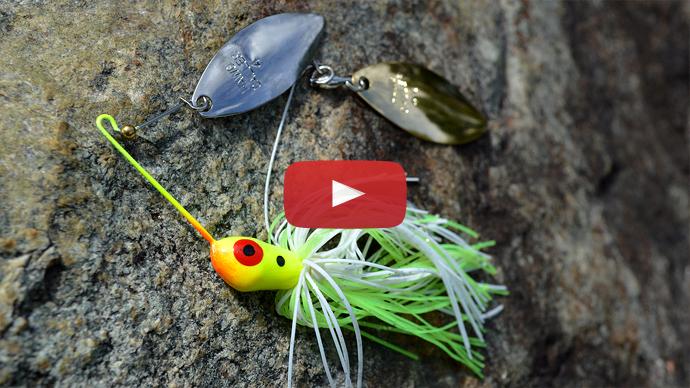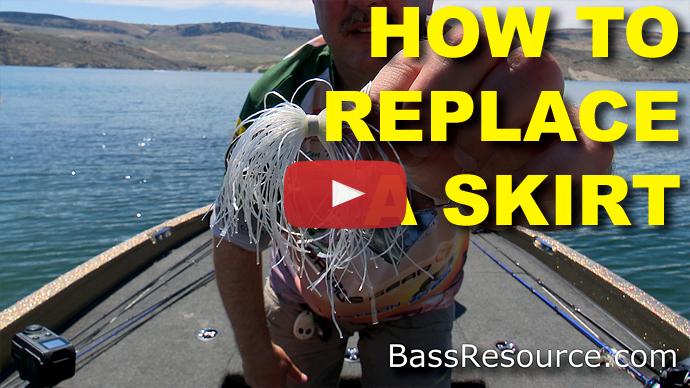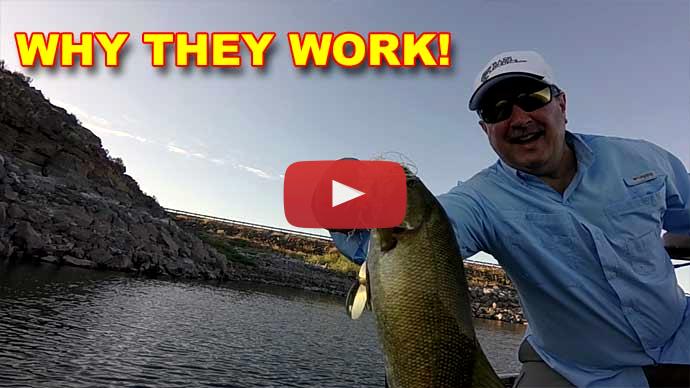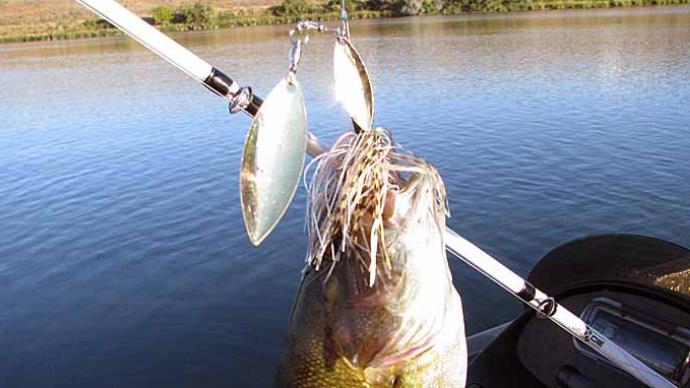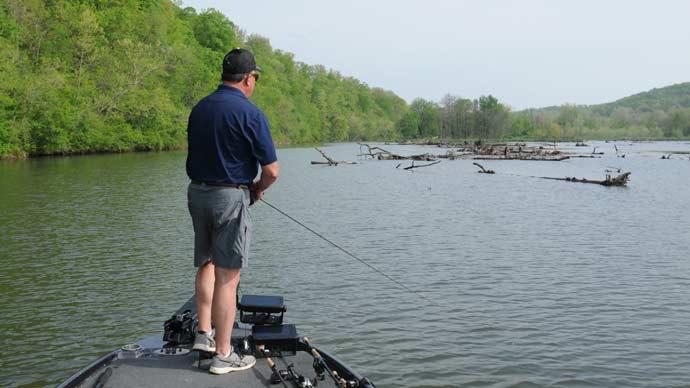Spinnerbaits are one of the most versatile baits you can have in your tackle box, they can be fished over, under and through cover, they can be fished just above the surface or all the way crawled on the bottom. In short, they can be used year round, all 365 days of the year, in all weather conditions. It just depends on how you fish it, what type of bait that you choose and what kind of cover you're going to be fishing under.
Let's try it out today. There are three primary types of blades, you have your Colorado blades, your Indiana blades and your Willow Leaf blades. Now the difference between the three is the Colorado blade puts out an awful lot of vibration and it can spin at a very slow rate. You can barely move that bait and that Colorado blade's going to start turning, it puts out a heavy, heavy vibration.
Conversely, the Willow Leaf blades, those don't put out a whole lot of vibration but they have a lot of flash to them which are great for when the Bass are schooling on bait fish and that sort of thing, that's what you want to focus on. Also the cool thing about the Willow Leaf blades is that they're pretty much weedless so if you're fishing through some heavy, heavy weeds like hydrilla and millfoil and that sort of thing the Willow Leaf blade might be your choice that you want to go with.
For me, I like the Indiana blades. That's sort of a mix between the two, they put off enough vibration that the Bass can hone in on it but yet they don't slow the bait down, there's not a whole lot of drag on it so I can fish it really fast without the bait turning on its side. So I really like it, it's very versatile. I can fish it very slow, very fast and I don't have to change baits.
As for blade color, primarily there's three different types you can choose from, there's a plethora of colors you can pick between but usually there's gold, there's silver and then there's some painted blades, you can get like white or chartreuse. Typically what you want to do for color choice is with gold blades you want to fish those on cloudy days or when the lake is murky. Silver color blades are really good for bright sunny days and when the water's really clear, that's when you want that nice, bright flash or when the bass are feeding on bait fish, that sort of thing. You'll get that silver flash that the bait fish give off.
Typically what I like to do is fish with the gold blades, even when it's sunny out. Typically the bass will smack that thing, mainly because in my neck of the woods where I'm fishing the bass primarily feed on Perch and that gold color tends to be what they focus on.
Now you'll see that most of these baits, they have tandem blades on it but there's also a single blade bait. Now the difference between the two is a tandem blade will give you a little bit more vibration, it gives you a little bit more lift and you can fish them faster because they have a little more even keel to them. So you can fish it just under the surface at a pretty fast clip and the bait won't lean over to one side or the other. Now with the single blade, that gives off a lot of vibration. You can slow roll it, meaning you can crawl it right along the bottom of the lake and they'll still remain upright and you can do it at a very slow speed.
When you're choosing a spinnerbait, I like to choose ones that have a thinner wire diameter on the arm. The reason being is because that allows that blade to give off a lot of vibration. The downside of that is that eventually that arm is going to break, at some point it's going to break. That's just the way it is. To me, spinnerbaits are expendable. You spend five, six bucks on a pack of plastics and you go through several packs a year. Spinnerbaits, same sort of thing.
You spend a couple bucks on them and you go through three or four of them a year, that's just how they are, now that's if you use them a lot. So the thinner diameter wire gives off that ability for that blade to give off that vibration, you really feel it and it allows the Bass to hone right in on it. So focus on that when you're looking at a spinnerbait.
Another thing that you want to look at when you are looking to buy a spinnerbait and you're looking at them on the rack, is check this ball bearing. Usually a Sampo bearing is one you want but oftentimes you can't tell what the brand is so the best way to check is just to give it a little flick, and you see how long that thing spins? The longer the blade spins the better. That gives a real chance for that blade to, it'll start spinning right when you just move it, just barely give it a pop and that blade will start going. Any blade that doesn't keep spinning like that, put it back on the shelf and put it away.
So let's talk a little bit about the skirts and the trailer. If you notice, this isn't a silicone skirt. A lot of baits come with them, I throw them right out. I replace them with a Lumaflex skirt which is this hairy looking thing right here. Reason I like Lumaflex skirts is they undulate a lot better under the water, they give off a lot more color, it's really reflective and I don't know why, I can't tell you, but the Bass absolutely annihilate it. I've used silicon skirts before but for some reason they just don't give off whatever it is that the Bass is looking for, I replace them with the Lumaflex and they just annihilate it.
Now here's the thing, they're kind of hard to find. You have to look everywhere to find it, you go online, do some searching for Lumaflex skirts, eventually you'll find somebody who sells it. When you do, buy it in the 100 pack. It's only a few bucks, you know, maybe 10 bucks and you get 100 of them so it's really cheap. You're going to go through several of these before the spinnerbait breaks. Reason being is, is as you use them this gets real poofy, this one's been used a few times. As you use it more and more it begins to look like Tina Turner with a bad hair day. Really, it looks like Phyllis Diller. It gets all mangled and tangled and the bait just gets all, and these skirts will eventually wrap up around the blade and get hung up on it. At that point just rip it off and put a new one on.
As for the trailer I like to use, I like to use a little twin tail. This particular one is a Zoom, I think it's white, pearl white, yeah, pearl white trailer. Nice and straight, it gives a nice even keel, allows the bait to track straight and it gives off a little bit of action, not so much a vibration but just a little kicking action on the back of the bait, just adds a little more appeal for the Bass.
If you notice, it's nice and straight, now this is key, this is real key. Sometimes what will happen is you'll rig it and you'll see that this hangs down nice and straight but if you look closely this is crooked. Many times what happens when you see a bait coming through the water and it's ticked off to one side a lot of the times, you'll read this in articles on the web and whatnot, people will say, "Bend the arm back and that will straighten it out." Really the first thing you ought to do is if you've got a trailer on make sure it's straight all the way, even if it's kinked up here.
What happens is aerodynamics completely change in the water and it can make the bait flip over to one side or the other and that's what's causing it, not the blades. So before you adjust the arm to get it right back on track make sure that this is on nice and straight. If that is nice and straight and it works just the way it's supposed to then you bend the arm. You can bend it one way or the other to get it to track nice and straight but that's what you want it to do.
I also take the bait and if you notice, I opened it up a little bit. That gives the ability for the Bass to eat, for this hook to nail them instead of them clamping down and this could end up being used like a weed guard. So just open it up a little bit and that way there's a lot more exposure for the hook to, for the bass to hit it.
Now that's still going to be weedless. That's the beauty about this bait is it's very, very weedless. You can fish it just about anywhere you would fish a jig and not get hung up. Guys, don't be afraid to throw it in the junk. That's what I really like to do, and that's when you're really going to catch an awful lot of fish. Just throw it in the bushes, throw it in the trees, throw it in any type of thick cover that you see. This is going to come through, you'd be really surprised at how well it goes through. But for that very reason, that's why I don't use a trailer hook.
Trailer hooks tend to snag up a little bit more and they tend to interfere a little bit with the trailer so I don't use trailer hooks. A lot of people like to use them because if they get a short strike then they put the trailer hook on and that'll catch the fish. For me, I've discovered that if you're getting follows or if you're getting short strikes that means you need to change colors somewhere.
Typically, it's the blade color oddly enough. What I'll do is I'll just swap off, if this is a gold blade I'll switch to a silver blade and that usually will illicit the bites. Or just change the front one, sometimes it's just the front one is all you need to do. But change the blade color first if you're getting short strikes or getting follows and typically that will change, that Bass will start nailing them and if they don't then you want to change the skirt color or change the trailer. Dip in chartreuse dye, whatever you need to do but just change the color and that's what's going to get them to smack it and glom on to it.
As for color, you can fish any color you want as long as it's white. Now the reason, I'm pretty honest about that, but the reason being, the reason why you want to pick white is because you can change this to anything you want. I use JJ's Magic and what I like to do is dye the skirt or dye the trailer. This is another reason why I use the Lumaflex skirts is because they absorb that dye and it puts off a real vibrant, vibrant color what the silicone skirts won't do. Same with the white trailer, is you can dip that in any color that you want and it's really going to bring that color out.
Now if any of you've noticed on the web or any of the seminars that we've done with JJ's Magic is you can take your plastics and basically color them anything you want. Same thing with a spinnerbait. You can color that skirt whatever you want, you can give it multicolor, I like to take a little bit of red dye, put it in, a little bit of chartreuse and leave some white in there so we've got a multicolor. Same thing with the trailer, you can color it anything you want, I'll take the body of the trailer and then dip that in red and then dip the tips in chartreuse. Whatever your imagination is you can do it using JJ's Magic. So that's why I pick everything in white to start off as a base and then color it at will.
Also when you're choosing spinnerbaits you'll want to look at size. There's all kinds out there from an eighth ounce all the way to over an ounce. For me, I don't get that much into them. I've been fishing spinnerbaits for decades now and really, what I've discovered is the three quarter ounce spinnerbait is what you want to throw. Reason being, is it's easier to throw in the wind, it's easier to cast, it's easier to bring back at fast rates.
A lighter bait, when you bring it back really fast under the surface it's going to tip over no matter what you do, no matter how well you straighten the arm, no matter how well you've done the trailer, it's still going to tip over if you bring it back quick. Three quarter ounce won't do that. The other thing about three quarter ounce is that you can bring it back really slow, right along the bottom of the lake or the bottom of the river. You can bring it back at any level that you want, at any speed you want and in any cover that you want. It's extremely flexible and versatile, that's why I like to throw it.
And as I mentioned before, you can throw it in the bushes and the trees, this will crash right through them. It's what I call a crashing the bushes. You throw it in there really hard and it'll crash right through and get right in to where the Bass are. You can't do that with a smaller spinnerbait. So, three quarter ounce, that's what I use year round. The only other time that I won't, well downsize is right after the spawn when there's a lot of smaller bait fish out there and the Bass are keying on that I will downsize maybe to a three eighth ounce, maybe a quarter ounce but typically three eighth ounce for about three or four weeks after the spawn. For the rest of the year, three quarter ounce.
Let's talk a little bit about equipment right now. Usually like I said I'm fishing a three quarter ounce spinnerbait so to match that I use a heavy action rod, usually medium heavy action rod. Reason being is because this bigger spinnerbait has a bigger hook so you're going to need that power and action to drive the hook into the jaw of the mouth. If you're using a smaller bait like a three eighth ounce or a quarter ounce then you'll want to downsize on your rod too. Go with a medium action or maybe a worm type rod. That way you don't overpower it and you can also still set the hook on it.
Now what a lot of guys do, they go with a lighter action rod because typically when a Bass smacks one of these things they really inhale it and you're going to feel it instantly and your reaction is to set that hook right away, thing is, is that you're going to end up ripping it right out of his mouth before he has a chance to clamp down on it. So with a softer action rod or maybe a fiberglass composite that will give you a little bit of that give and just gives you a little bit more time before you load up on that rod and gives you a chance for that Bass to grab it before you set the hook.
I like to, I've been fishing it for a while so after a while you get used to that, you get used to just giving it a little bit of a pause, a little bit of hesitation before you set the hook. It's a matter of personal preference, whatever you like to do. I like to use 14 or 15 pound test line, again, fishing real nice heavy hook but again, I like to throw this into heavy, heavy cover. Lots of bushes, laydowns, that sort of thing so you're going to need a heavier diameter line to go through all that stuff.
What I don't recommend is using spinning gear. Don't ever use spinning gear with spinnerbaits because you're just going to be disappointed. Spinning gear doesn't have the backbone to set the hook, you're going to have to use lighter line like eight pound, ten pound line and that line's going to get all roughed up and it's going to break off on you if you're fishing in rocks and that sort of thing so don't use spinning gear.
Also if you notice I tie directly to the lure, I don't use a snap, don't use a swivel. Those just tend to get in the way and get wrapped up around where you tie it on and it actually hinders the action of the spinnerbait. Just tie directly to it.
The key to fishing spinnerbaits is in the way you cast them. A lot of people, they've done everything right, they've chosen the right spinnerbait, they've put the right skirts on it, they've got the right color, everything down to exactly what they want to do and then they end up spooking the Bass because of the way they're casting it.
Really the key with fishing the spinnerbait is you want a low trajectory and a soft entry into the water, just like an Olympic diver right into a pool. As little wake as you can possibly do. A nice quiet entry, you're going to get a lot more strikes when you do that. So, you can't do that with an overhand cast, you're just not going to be able to. So the only time I actually use an overhand cast is when I'm in a big flat and I'm trying to cover lots of water, I'm randomly casting, I'll just start like at the nine o'clock position, the next cast will be at 10, the next one will be at 11, that sort of thing. Just to cover a lot of water because if it's real weedy, that sort of thing you'll probably bring it right across them as they're sitting in the weeds but other than that I use an underhand cast.
And there's two different types you can do. One's a forward underhand cast and the other one's a backhanded cast. Let me show you these. Now the forward cast is actually pretty simple to do, this is a one handed cast, all you do is you just give it a little cast just like that. Very simple as you can see. That's a three quarter ounce spinnerbait and it made a real light entry. I can actually do it a little bit better than that. What you really want to do is give it a nice, low trajectory right into the water, just like that. That's what you're looking for, a real nice, low trajectory. It doesn't come crashing down with a giant splash or anything like that, that's what you want to practice on. It's going to take a little bit of practice to do it, a little bit of practice with the thumb as well. As you practice with that thumb that's what you want to focus on is that light entry and a heavier spinnerbait makes it easier to do that.
Now do that cast, it's just a one handed cast and really, all it's like, if you've never done this before, it's just like turning the handle on a doorknob except you're also giving it a little bit more of a backwards letter C as you turn. That's really all there is to it, watch my arm when you do this, you'll see I'm not taking the arm and swinging it and doing any of that crazy stuff, it's all in the wrist, it's just like that, that's all you do.
The other cast which takes a lot more practice to master but it's really worth doing is the backhanded, underhanded cast. It looks just like this. 'K, very simple cast once you learn how to do it. Trust me, it takes a little bit of practice but folks, this is really worth learning how to do. It opens up a whole new field of targets. Again, you just underhand just like that. It's kind of like, it's sort of like a weird backhanded golf swing or if you're left handed, baseball bat swing if you're going for a real low bat, you know, low ball.
It's kind of awkward when you first learn how to do it but what this allows you to do is you can target the back side of targets, the back side of docks. This is really good if you're a back seater because the front seater, if he hasn't learned how to do this cast, folks if you're in the back seat it just opened up a whole new bevy of targets that the front seat can't get to. The other thing about this backhanded cast is it allows you to fish either on this side of the boat or that side of the boat, either way you've got a cast you can use to get that low trajectory, get it up under the trees, under the docks and that nice, soft entry that you're looking for.
It doesn't matter what side you're fishing on you can do it. Doesn't matter if you've got consoles in the way or trolling motors or you're engine in the way, whatever. You can either use the front-handed or the backhanded cast to get that bait right where you want to. The thing about the backhanded cast, really the key about that is when you release it with your thumb. That's what takes practice. Practice with that, sit down for a few hours, I assure you it will take a while to learn but once you do, man you're going to love it because it's going to open up a whole lot of new targets you can cast at.
There we go. Fish on. Come here you. Yee haw. All right. That's what a spinnerbait can do right there for you. Nice two pound smally. I guarantee you guys, you keep throwing these things you're going to catch fish just like this.
Well, I hope these tips certainly help you out, especially if you're a beginner but even if you've been using spinnerbaits for a long time I hoped you picked up a few little tips, it's going to help you catch a lot more fish with them. If you have any more questions please go to BassResource.com/spinnerbaits. Thanks for watching.

